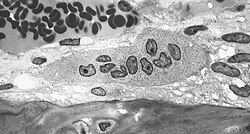Bone resorption
Editor-In-Chief: Prab R Tumpati, MD
Obesity, Sleep & Internal medicine
Founder, WikiMD Wellnesspedia &
W8MD medical weight loss NYC and sleep center NYC
| Bone resorption | |
|---|---|

| |
| Synonyms | |
| Pronounce | N/A |
| Specialty | N/A |
| Symptoms | Bone pain, fractures, osteoporosis |
| Complications | Hypercalcemia, osteopenia |
| Onset | |
| Duration | |
| Types | |
| Causes | Osteoclast activity, hormonal imbalance |
| Risks | Age, menopause, immobility, calcium deficiency |
| Diagnosis | Bone density test, X-ray, blood test |
| Differential diagnosis | Osteomalacia, Paget's disease of bone |
| Prevention | Calcium and vitamin D supplementation, weight-bearing exercise |
| Treatment | Bisphosphonates, hormone replacement therapy, calcitonin |
| Medication | Bisphosphonates, denosumab |
| Prognosis | |
| Frequency | Common in older adults |
| Deaths | |
Overview of bone resorption process
Bone Resorption
Bone resorption is a critical physiological process in which bone tissue is broken down and the minerals, such as calcium, are released into the bloodstream. This process is essential for the maintenance, repair, and remodeling of bones throughout life. It is primarily carried out by specialized cells known as osteoclasts.
Osteoclasts
Osteoclasts are large, multinucleated cells that originate from the monocyte-macrophage lineage. They are responsible for the degradation of bone matrix and the release of stored minerals. Osteoclasts attach to the bone surface and create a sealed environment where they secrete acids and proteolytic enzymes to dissolve the mineralized matrix and collagen fibers.
Mechanism of Bone Resorption
The process of bone resorption involves several steps:
- Osteoclast Activation: Osteoclasts are activated by signals from osteoblasts and other cells. Key signaling molecules include RANKL (Receptor Activator of Nuclear Factor Kappa-_ Ligand) and M-CSF (Macrophage Colony-Stimulating Factor).
- Sealing Zone Formation: Osteoclasts form a tight seal with the bone surface, creating a specialized compartment known as the resorption lacuna.
- Acidification: The osteoclasts secrete hydrogen ions into the resorption lacuna, lowering the pH and dissolving the inorganic components of the bone.
- Enzymatic Degradation: Proteolytic enzymes, such as cathepsin K, are secreted to degrade the organic matrix, primarily collagen.
- Endocytosis and Transcytosis: The degraded bone matrix is endocytosed by osteoclasts and transported across the cell to be released into the extracellular space.
Regulation of Bone Resorption
Bone resorption is tightly regulated by various hormones and cytokines to maintain calcium homeostasis and bone integrity. Key regulators include:
- Parathyroid hormone (PTH): Increases bone resorption to raise blood calcium levels.
- Calcitonin: Inhibits osteoclast activity, reducing bone resorption.
- Vitamin D: Enhances the resorptive activity of osteoclasts by increasing calcium absorption.
- Estrogen: Inhibits bone resorption, and its deficiency (as in menopause) can lead to increased resorption and osteoporosis.
Clinical Significance
Abnormal bone resorption can lead to various bone disorders. Excessive resorption can result in conditions such as osteoporosis, where bones become weak and prone to fractures. Conversely, insufficient resorption can lead to osteopetrosis, a condition characterized by overly dense but brittle bones.
See also
Transform your life with W8MD's budget GLP-1 injections from $125.
W8MD offers a medical weight loss program to lose weight in Philadelphia. Our physician-supervised medical weight loss provides:
- Most insurances accepted or discounted self-pay rates. We will obtain insurance prior authorizations if needed.
- Generic GLP1 weight loss injections from $125 for the starting dose.
- Also offer prescription weight loss medications including Phentermine, Qsymia, Diethylpropion, Contrave etc.
NYC weight loss doctor appointments
Start your NYC weight loss journey today at our NYC medical weight loss and Philadelphia medical weight loss clinics.
- Call 718-946-5500 to lose weight in NYC or for medical weight loss in Philadelphia 215-676-2334.
- Tags:NYC medical weight loss, Philadelphia lose weight Zepbound NYC, Budget GLP1 weight loss injections, Wegovy Philadelphia, Wegovy NYC, Philadelphia medical weight loss, Brookly weight loss and Wegovy NYC
|
WikiMD's Wellness Encyclopedia |
| Let Food Be Thy Medicine Medicine Thy Food - Hippocrates |
Medical Disclaimer: WikiMD is not a substitute for professional medical advice. The information on WikiMD is provided as an information resource only, may be incorrect, outdated or misleading, and is not to be used or relied on for any diagnostic or treatment purposes. Please consult your health care provider before making any healthcare decisions or for guidance about a specific medical condition. WikiMD expressly disclaims responsibility, and shall have no liability, for any damages, loss, injury, or liability whatsoever suffered as a result of your reliance on the information contained in this site. By visiting this site you agree to the foregoing terms and conditions, which may from time to time be changed or supplemented by WikiMD. If you do not agree to the foregoing terms and conditions, you should not enter or use this site. See full disclaimer.
Credits:Most images are courtesy of Wikimedia commons, and templates, categories Wikipedia, licensed under CC BY SA or similar.
Contributors: Prab R. Tumpati, MD


